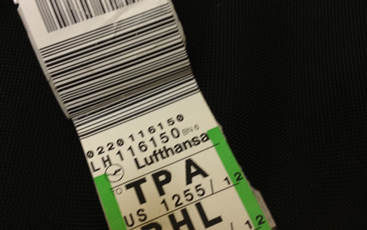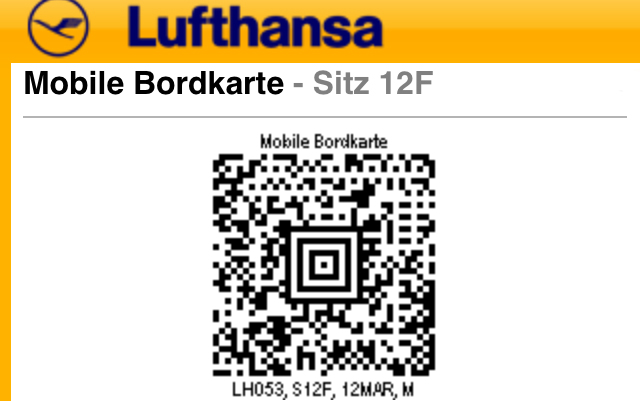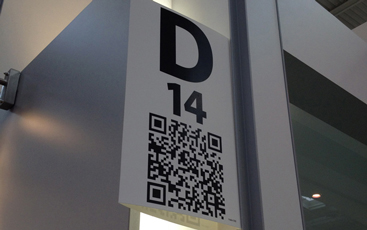It’s a Barcode World
 Eric Moody, reporting on CeBIT 2012 for The BarCode News, observes the prevalence of barcodes in our day-to-day lives.
Eric Moody, reporting on CeBIT 2012 for The BarCode News, observes the prevalence of barcodes in our day-to-day lives.
In today’s world, RFID chips are everywhere. For the most part, though, they are working behind the scenes. Barcodes are more visible, especially when you go looking for them. Both are likely a frequent part of your day-to-day life. They are also a huge part of modern travel, both here and abroad.
Travel along on a quick business trip to Europe and you’ll see just how pervasive--and indispensible--barcodes and RFID have become.
Upon arriving at the airport, pull up to the gate at the long-term parking garage and press the button for a ticket. The ticket has a mag strip on it, which will help you part with a decent chunk of change when you return and pay for parking, most likely, with a mag-stripped credit card.
If you’ve printed your boarding pass at home already, it either has a 2D barcode or a QR code. You can save paper nowadays by presenting your  e-ticket’s QR code on your smartphone. When it’s your turn at the gate, simply hand your phone to the attendant who will scan it and pass it back to you. In most cases I’ve seen, this process works even more quickly than scanning the paper tickets.
e-ticket’s QR code on your smartphone. When it’s your turn at the gate, simply hand your phone to the attendant who will scan it and pass it back to you. In most cases I’ve seen, this process works even more quickly than scanning the paper tickets.
Oh, so you’re going abroad? Passport, please. If you hold a U.S. passport, your passport number is encoded in glorious 2D on the inside of the back cover. Of course, if your passport was issued any time since 2007, it also contains a tiny 64k passive RFID chip embedded in that same cover. The chip is encoded with the same personal info as the printed passport, including a digitized photo. (More info on the RFID used in U.S. passports at http://travel.state.gov/passport/passport_2788.html#Eight)
Checking a bag? Whether or not you’re paying for that first bag, the airline’s machine spits out a strip and tags your bag with the route and destination printed in bold letters and encoded in a 2D barcode. You’ll get a small version stuck to your boarding pass, also with a barcode, just in case you or your bag somehow get sent in different directions.
Buy a snack or drink on the plane? Credit card with mag strip, please. Your in-flight magazine will have a slew of ads with QR codes (a great involvement device, especially if your flight happens to have wi-fi).
After landing, going through customs, and picking up your luggage, you pick up your rental car. The keychain probably has a barcode on it. And, if you’re curious and look at the driver’s side door of your rental car, you will likely find a couple more barcodes there. Now you’ve arrived and head for your destination, a major trade show. After registration, you’ll likely be sporting a barcoded name tag hanging from a lanyard which will need to be scanned every time you enter the exhibition area. Also, many booths you visit will be more than happy to scan your tag so they can add you to their CRM database, no typing required.
Now you’ve arrived and head for your destination, a major trade show. After registration, you’ll likely be sporting a barcoded name tag hanging from a lanyard which will need to be scanned every time you enter the exhibition area. Also, many booths you visit will be more than happy to scan your tag so they can add you to their CRM database, no typing required.
As you meet people and network at the show, you’ll notice that some people will give you business cards with QR codes on them. They can include all the typical contact info, plus a link to their company website, even a brief memo. Again this saves everyone the hassle of keying data in by hand. Nobody at the booth, or perhaps you don’t have the time to stop and talk? No problem. Many shows are now posting booth numbers and QR codes at each booth, so you can scan the code and follow up for more information later. As you move from aisle to aisle, you’ll also find QR codes to scan to enter exhibitors’ contests and promotions.
Fast forward to your return trip, and it’s the same story: RFID taking care of a lot of the logistics and barcodes and mag strips handling the rest. You’re living in a barcode world, and if you live in a place where there’s a gate to go through when you’re almost home, chances are there’s a barcode on your window or an RFID chip on your windshield to take care of that, too.
About CeBIT 2012
"CeBIT is the world's largest trade fair showcasing digital IT and telecommunications solutions for home and work environments. The key target groups are users from industry, the wholesale/retail sector, skilled trades, banks, the services sector, government agencies, science and all users passionate about technology. CeBIT offers an international platform for comparing notes on current industry trends, networking, and product presentations.” Learn more at the CeBit 2012 website.
About the AuthorEric Moody covers barcode and POS industry events worldwide, with a particular eye toward new product development and user experience. A graduate of Brown University and Thunderbird School of Global Management, he was formerly editor of Business Digest magazine. He has been active in the retail systems world for more than 20 years.
Related articles:
CeBIT 2012: RFID to the Rescue
More From CeBIT: RFID-Based Automotive Network (RAN)
{jcomments on}
